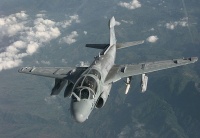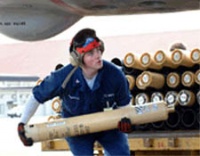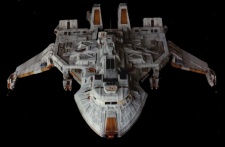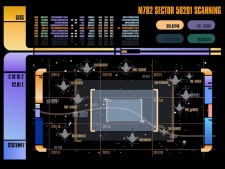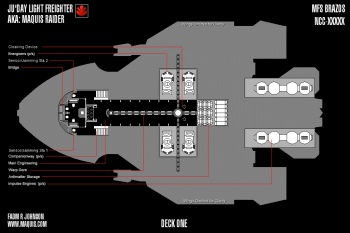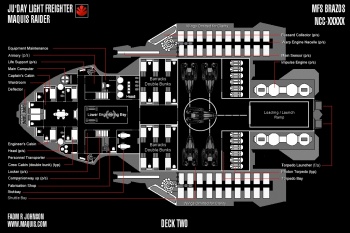Maquis SIM Project/Fighters/VAQ-09
| Line 8: | Line 8: | ||
[[Image:Ea6bprowler.jpg|thumb|200px|EA-6B]] | [[Image:Ea6bprowler.jpg|thumb|200px|EA-6B]] | ||
[[Image:Ao-sonobouy.jpg|thumb|200px|Sonobuoy]] | [[Image:Ao-sonobouy.jpg|thumb|200px|Sonobuoy]] | ||
| − | + | The EA-6B Prowler was a twin-engine, mid-wing aircraft manufactured by Northrop Grumman Aerospace Corporation as a modification of the basic A-6 Intruder airframe. Designed for carrier and advanced base operations, the Prowler was a fully integrated electronic warfare system combining long-range, all-weather capabilities with advanced electronic countermeasures. A forward equipment bay and pod-shaped faring on the vertical fin house the additional avionics equipment. It was the United States Navy's and the United States Marine Corps's primary electronic warfare aircraft. The primary mission of the aircraft was to support strike aircraft and ground troops by interrupting enemy electronic activity and obtaining tactical electronic intelligence within a combat area. Since the retirement of the EF-111 Raven in 1995, it was the only aerial radar jammer in the Department of Defense arsenal. It was utilized in practically every US combat operation and frequently loaned to the United States Air Force. <br> | |
| − | + | ||
| + | The Prowler had a crew of four, a pilot and three Electronic Counter-measures Officers (known as ECMOs). Powered by two non-afterburning Pratt & Whitney J52-P408 turbojet engines, it was capable of speeds of up to 950 km/h with a range of 1,840 kilometers. Since EW operations are very demanding, the Prowler was a high-maintenance aircraft and also undergoes more frequent equipment upgrades than any other aircraft in the Navy. Although designed as an electronic escort and command and control platform for strike missions, the EA-6B was also capable of attacking surface targets on its own especially radars, SAM launchers, and other enemy defenses. The AGM-88 HARM (High-speed Anti-Radiation Missile) was the main offensive strike weapon of the Prowler. In addition, the aircraft was highly capable of conducting electronic intelligence (ELINT) collection. | ||
Revision as of 00:26, 8 June 2006
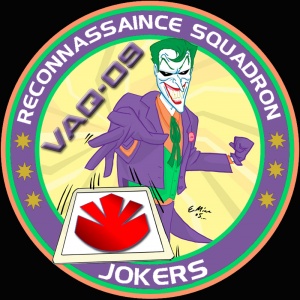
Attack Reconnaissance Squadron (VAQ) 09
"Jokers"
Aircraft
The EA-6B Prowler was a twin-engine, mid-wing aircraft manufactured by Northrop Grumman Aerospace Corporation as a modification of the basic A-6 Intruder airframe. Designed for carrier and advanced base operations, the Prowler was a fully integrated electronic warfare system combining long-range, all-weather capabilities with advanced electronic countermeasures. A forward equipment bay and pod-shaped faring on the vertical fin house the additional avionics equipment. It was the United States Navy's and the United States Marine Corps's primary electronic warfare aircraft. The primary mission of the aircraft was to support strike aircraft and ground troops by interrupting enemy electronic activity and obtaining tactical electronic intelligence within a combat area. Since the retirement of the EF-111 Raven in 1995, it was the only aerial radar jammer in the Department of Defense arsenal. It was utilized in practically every US combat operation and frequently loaned to the United States Air Force.
The Prowler had a crew of four, a pilot and three Electronic Counter-measures Officers (known as ECMOs). Powered by two non-afterburning Pratt & Whitney J52-P408 turbojet engines, it was capable of speeds of up to 950 km/h with a range of 1,840 kilometers. Since EW operations are very demanding, the Prowler was a high-maintenance aircraft and also undergoes more frequent equipment upgrades than any other aircraft in the Navy. Although designed as an electronic escort and command and control platform for strike missions, the EA-6B was also capable of attacking surface targets on its own especially radars, SAM launchers, and other enemy defenses. The AGM-88 HARM (High-speed Anti-Radiation Missile) was the main offensive strike weapon of the Prowler. In addition, the aircraft was highly capable of conducting electronic intelligence (ELINT) collection.
Spacecraft and Mission
Attack Reconnaissance Squadron NINE (VAQ-09) is made up of nine Maquis Ju'Day Raider Class starships. These modified transports have been outfitted with weaponry and a variety of other mission specific equipment. Specifically tasked to Patrol the Badlands and established Maquis bases, VAQ-09'S Raiders are mostly outfitted with special and highly tuned sensor equipment designed to serve as early warning for attacks or detecting hostile forces in areas in which the Maquis operate.
The mission of VAQ-09 includes communications intrusion, deception and jamming of hostile units in and around the Badlands. Utilizing special jamming equipment, ships of VAQ-9 can even use the sensors of hostile units against themselves by projecting "ghost" images of themselves, mirroring positions of the hostiles themselves, and generally any means necessary to ensure that they are looking anywhere except where Maquis assets are actually positioned.
A typical tactical ploy for VAQ-09 upon detecting a hostile presence near a Maquis asset is to project the sensor ghosts of the Maquis squadron. The squadron of nine Ju'Day's become four to five fold prompting the the hostile unit to flee or tempting them to pursue. Either way, the tactic is to ensure the "joke" is on them and at the end of the day, the hostile winds up with nothing. VAQ Squadron's Raiders have had Cloaking technology added in order to assist with the stealth needed to assist them in their redirection techniques. The five Type-9 Shuttles have also been fit with modified sensors, as well as having their engines tuned to make their "Signatures" appear as larger craft, enhancing the diversionary effect.
The crews of VAQ-09 pride themselves on never being discovered when reconnoitering an area. Even though intrusion, deception, and jamming are their weapons in their collective arsenal, their primary strength is to employ stealth and exploit the weaknesses of their quarries. If they can return to base and avoid ever been seen, they they have done their job for the day.
Specifications & Deck Plans
| |
Star Trek®, StarTrek.com, Star Trek: The Next Generation®, Star Trek: Deep Space Nine® and Star Trek: Voyager® are registered trademarks of Paramount Pictures & Viacom. All material on these pages are for promotional purposes only. No infringements on their copyrights is intended. These are Star Trek Fan Sites. |
